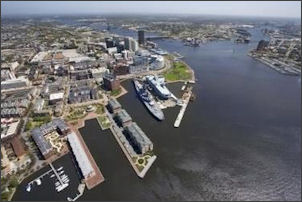by James A. Bacon
With military spending throttled by sequestration, the Hampton Roads economy needs help. The logical place to turn is the Ports of Virginia, which are well positioned, thanks to their deep channels, to benefit from the widening of the Panama Canal in 2015. How can Virginia and the Hampton Roads region leverage the anticipated increase in container traffic into sustained economic growth?
A new report by the Organization for Economic Cooperation and Development might provide some useful advice. “The Competitiveness of Global Port-Cities” outlines three broad strategies for increasing the local economic benefits of ports around the globe.
Building maritime clusters. Ports stand at the center of economic clusters tied to maritime activity, including obvious things like railroads, trucking companies, warehouses, ship repair, freight-forwarding companies and the like, and less obvious things like maritime law, insurance and finance. Many port cities around the world have made it an object of policy to build their port clusters. Some have been successful, some have not. “Clusters cannot be created ex nihilo through policy,” warns the report. “In most instances clusters emerge through path-dependent and market-induced processes, meaning that not all maritime clusters can be encouraged in the same manner.”
Developing port industry. In many cities industrial activity has spontaneously arisen around their ports, taking advantage of lower transportation costs. But port cities also can foster industrial development through pro-growth policies. The key motive behind the McDonnell administration’s $1.4 billion upgrade to U.S. 460 between Petersburg and Suffolk is to open a second highway route out of Hampton Roads and to stimulate industrial development along the corridor. But not all linkages need be with manufacturing. Indeed, the OECD report highlights a different Hampton Roads initiative — the SEVA-PORT partnership — as worthy of global notice.
Through the SEVA-PORT partnership, Virginia aims to tether its well-developed port cluster – and especially the industries involved in transportation, warehousing and distribution – to the sector of computer modelling and simulation, which specializes in the creation of sophisticated models for use in the fields of gaming, engineering, and medicine, and is also crucial to the operational aspects of logistics. In addition to creating this economic synergy, the policy is also intended to work as an inclusive employment mechanism, and to this end has implemented a diverse array of training programs….
The key mechanisms of the policy focus on upgrading the educational opportunities that will create a labour pool at the nexus of these two industries. This involves integrating certificate programs for warehousing and distribution, truck driving, and modelling and simulation into the degrees offered by community colleges, and the expansion of internship opportunities in these same sectors through links with the private sector.
Urban waterfront development. As container shipping consolidated port activity in a handful of mega-facilities, economic activity moved away from traditional waterfronts. The potential exists to re-purpose that urban waterfront as a focal point where people “enjoy the visceral pleasure of coming to the water’s edge and … share that pleasure with visitors or tourists” through marinas, fisheries, aquariums, cruise shop terminals, historical preservation and the throwing of mega-events.
Norfolk has gone this route, with the Nauticus Museum, the battleship Wisconsin, the cruise-ship terminal, waterside retail and events. Some of it has worked, some of it hasn’t. I have highlighted the woes of the cruise terminal. The city’s Waterside Festival Marketplace has had its share of financial woes as well.
Bacon’s bottom line: The OECD report makes dry reading but it does provide a useful framework for thinking about the challenges, and it highlights success stories from around the world that Hampton Roads regional leaders can draw from in their search for a winning formula.
Personally, I think waterfront residential should be part of any mix. People love looking at the water, and downtown Norfolk has a lot going on. My parents live in a retirement high-rise on the Elizabeth River. They peer through a telescope to get a close-up view of the goings on, from yachts traversing the Intra-Coastal waterway to Navy vessels getting repaired in dry dock. It’s a lot more interesting view than sitting in Virginia Beach and looking at the (mostly) empty Atlantic Ocean — although that could change if we start seeing wind farms and oil-drilling platforms!



